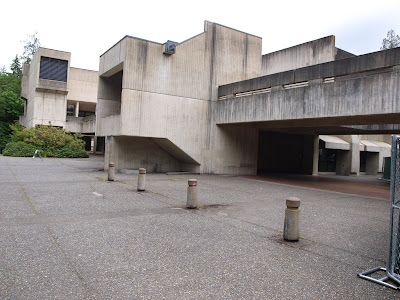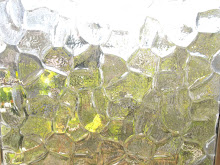
It's rare as an adult to have an experience that takes you out of your sense of the world, your constructed reality with all the bits and pieces of information that you're constantly assessing and aware of. It's something we form as we grow older and wiser - we see what works for us, in action and conception. We derive theses in accord or opposition to those around us and we test and refine them until they get to a point when we decide they work for us, and then we have beliefs. Beliefs become rigid over time and, like old rubber bands, increasingly less flexible, brittle. I think this is somewhere near what people are talking about when they wish upon you to be childlike, to stay young, to be young at heart, and so many other teeth-grinding abstractions.
Children are able to slip in and out of different realities easily. The dark corner of the house that is mundane during the day can suddenly become filled with terrible and unspeakable creatures when you get out of bed to go to the bathroom in the night. The kitchen cupboards and your parents closet can suddenly hold all manner of treasures when you find yourself home alone for an hour. People on the street can be spies, monsters, aliens, supporting actors in your story. Once a year a man slides down your chimney to give you presents and another hears your thoughts and helps you when you need it. This slipping between worlds is an endearing trait in children and a certifiable one in adults. Even while we adore it in children and mourn its eventual loss, we expect adults to be able to function in society, to be responsible and see themselves as part of a whole, with consistent and very nuanced sets of norms, values, behaviors and codes. For people who don't quite get these nuances, or openly defy them, we have a spectrum of means to acclimatize them of increasingly degrees of severity.
So why is it that the best experiences are experiences that seem to release us from this sense of reality? Those that artfully and utterly allow us to step outside the set of factors we're constantly assessing and taking information from and briefly experience that simple sense of wonder, of the unknown, of disorientation.
Cirque du Soleil is one of these such things. I've also experienced this with music, live and recorded, movies, books, live theater, religion or spirituality, drug use. Perhaps any art form, done well, aspires to create an alternate reality and draw us in to it. Perhaps as adults this is what we're ultimately seeking - to feel as though we don't have all the answers, as though everything in life isn't a known and accounted for quantity. Although maybe there's a way to see these greater shades of complexity and wonder within the everyday, without having to abnegate it, which is a different line of thinking that I'd like to explore more sometime.
I was fortunate enough to attend my third Cirque du Soleil tonight. It's a completely amazing thing that exists, and I recommend it to everyone with breath to sharply draw in and forget to exhale. There's something spectacular about seeing people who are the best in the world at what they're doing, who are defining the very boundary of what the human body is capable of in front of your eyes. As consumers, we're lucky to have the opportunity to witness these acts and I appreciate that someone thought to put together a multimillion dollar multinational circus troupe to make it happen. It fits its niche so well, it's hard to imagine there not being a Cirque du Soleil now that I've seen it.
The funny thing about it is, I always find myself watching the rigging men during the show, observing what the actors are clipping the caribbeaner on that pencil-thin, barely visible steel cable coming down from the ceiling on to. I find myself wondering where the performers stay when they're in town. Do they stay in hotels? Do they have roommates? Do they go out to bars after the show? Do they feel lonely and isolated from the town? Do they get along? Is there a hierarchy of importance among them? Do the clowns or the acrobats get paid more? Do all those fit, flexible specimens have spectacular sex? What is your life like growing up as a physical phenom? Do you have to start training before you're 5 to be that good at anything? Do you basically have to be forced into it by your parents or can someone actually figure out who they are, what they want, and develop the skills before their body loses the ability to learn such things? I guess I'm not entirely drawn into the reality that the show is presenting, but that is what I love about Cirque du Soleil.
In every show I've seen, there's a (very) loose narrative structure that gives the show backbone. There are usually 5-8 characters who make recurring appearances and perform skits between the acrobatics. There is usually a young, Innocent who is a conduit for the audience themselves entering this world. There is a mysterious, confidant Guide who introducing/creates the world. There are clowns who act as a foil to the more serious guide. Occasionally others, but these are the basic types. The acrobatic performers are more or less nameless characters who come and go in different costumes; there is usually a supporting cast and individuals who are highlighted in very specific acts you can tell they've spent their whole lives perfecting. Or maybe when you're that good, who can basically pick up any physical feat just by watching someone else do it and trying it a couple times.
I think Cirque du Soleil succeeds where it creates this narrative and atmosphere (including live music, dreamy singing in a language I never understand, excellent lighting and stage sets), drawing you into its world. From the big swirled yellow and blue tent to the clowns wandering around harassing audience members before the show, it is a very well crafted experience. I was trying to think of comparable events you can attend to have such an atmospheric experience, and I've come up with haunted houses and Wolves in the Throne Room shows I've been to (a Northwest black metal band). And this is what I always want from Cirque du Soleil. I always come away wanting it to go further. I want it to be darker, more complicated. To not have to cater to family audiences and undercut the intense and beautiful atmosphere with garden variety clowning, or delude it with feats performed purely for their skill that aren't worked in to the narrative. I want it to feel like it cuts you, to feel dangerous, like it threatens your sense of the world. To have moments of utter and profound beauty, to rise and swell and drive to a breathless tension just before it completely cuts away, like a Godspeed You Black Emperor! song. To be cut up and disjointed and uncomfortable like experimental short films. I want to leave thinking not, What a great time that was, I'm glad we did that, but to leave in a stunned silence, unaware of the throngs of the crowd around me, trying to puzzle through a flash flood of feelings built up over the last hour. I always prefer performances that leave you so caught up, it wouldn't occur to you to clap. I guess I want it to take what it's so good at and do it completely unapologetically.
Some day, when I'm directing circus performances, this is what I'll try to do. Hopefully it won't be too heavy handed.

























